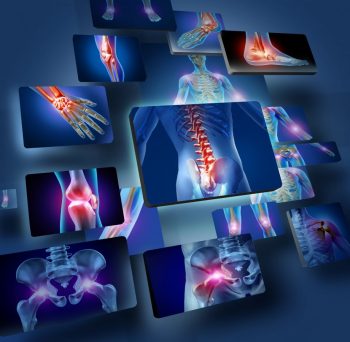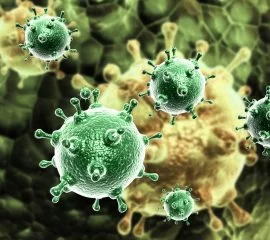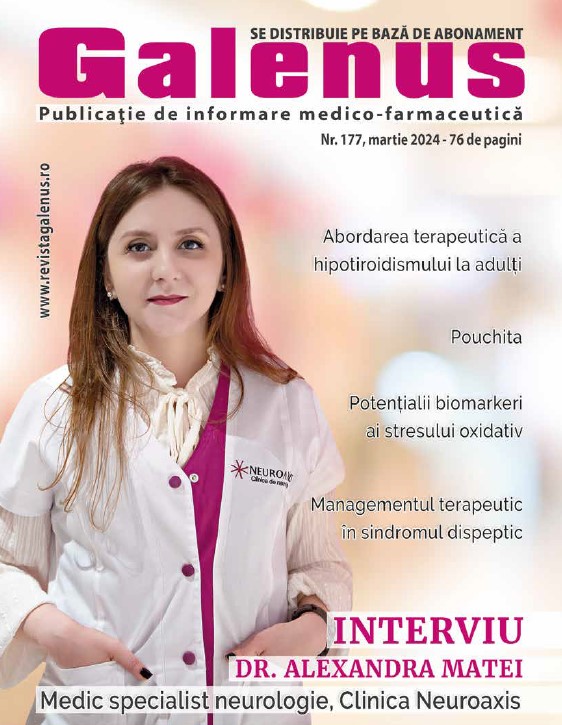Acasă » Practică medicală » New insights into bone remodelling cycle
New insights into bone remodelling cycle

Rezumat:
Aceasta lucrare reprezinta o trecere in revista a celor mai recente date din literatura referitoare la ciclul de remodelare osoasa privind mecanismul de cuplare al resorbtiei osoase cu cel al formarii osului prin generarea unui mediu osteogenic la situsurile remodelarii. Pana in momentul de fata, mecanismul de cuplare a ramas putin inteles, in ciuda identificarii unui numar de molecule osteogenice de cuplare.Un motiv posibil poate fi atentia redusa acordata celulelor care conduc la osteogeneza in cursul fazei inverse.
Cuvinte-cheie: ciclul de remodelare osoasa, molecule osteogenice, faza reversa
Abstract:
This paper is a review of the most recent literature data on bone remodeling cycle regarding the coupling mechanism of bone resorption to bone formation by generating an osteogenic environment at remodeling sites. Since now, the coupling mechanism remains poorly understood, despite the identification of a number of ‘coupling’ osteogenic molecules. A possible reason is the poor attention for the cells leading to osteogenesis during the reversal phase.
Keywords: bone remodelling cycle, osteogenic molecules, reversal phase
Introduction
The aim of bone remodeling is the replacement of existing bone matrix by new bone matrix. This process has a central role in adult bone physiology and a malfunction of bone remodeling leads to diseases such as osteoporosis. Bone remodeling is commonly seen as a two step process: bone resorption by osteoclasts followed by bone formation by osteoblasts. These two events have been a major research focus for many years, as reflected by the current drugs used in the clinic.[1]
However, the most remarkable property of bone remodeling is probably the subtle coordination between osteoclasts and osteoblasts.[1] This coordination allows keeping bone shape and structure largely unchanged throughout life, despite the repeated resorption and formation events the bone is subjected to. It has been recognized for a long time that this coordination is made possible because of the organization of osteoclasts and osteoblasts in local bone remodeling teams, called basic multicellular units (BMUs) [2].
The question why osteoblasts are recruited exactly where and when osteoclasts have removed bone matrix, has prompted a lot of research in the recent years, as indicated by the number of reviews on the coupling mechanism between osteoclast and osteoblast activities.[1,3] A major outcome of this research is the identification of a number of osteogenic molecules likely to be released by the osteoclasts. They include growth factors stored in the bone matrix and solubilized through resorbtive activity, as well as so-called clastokines that can be generated by ‘non-resorbing’ osteoclasts[4,5].
We may ask what are the cells that are subjected to the osteogenic factors released by the osteoclast? A simple analysis of the BMU shows that they cannot be bone-forming osteoblasts themselves, because these osteoblasts are distant from the osteoclasts. Histomorphometry of iliac crest biopsies from normal individuals indicates that this distance corresponds to a time interval of several weeks.[6] This intermediate period starting after the osteoclast has left and lasting until bone matrix starts to be deposited is defined as the ‘reversal phase’.[7,8]
It thus concerns the cell activities transforming the putative osteogenic signals of the osteoclast into bone formation, but these cell activities and the origin of the osteoprogenitors targeted by these signals are poorly investigated.[7]
This represents a gap in the knowledge that is required to fully understand the coupling process, especially when it comes to adult human cancellous bone and osteoporosis-relevant conditions.
Current knowledge suggests that the coupling activity of the reversal phase starts with the release of osteogenic signals from the osteoclasts.[1,4] These osteogenic signals will first reach the cells nearest to the osteoclast. These include both bone surface and bone marrow cells. The bone surface cells are the bone-lining cells of quiescent bone surfaces that have retracted to give the osteoclast access to the bone matrix, [9] as well as the mononucleated cells on the eroded surface in the wake of the osteoclast.[7]
The latter cells are called reversal cells, and cover at least 80% of the eroded surface, known as the reversal surface [7]. They form a cellular bridge connecting the resorbing osteoclasts and the bone-forming osteoblasts. As described earlier,[7,10] reversal cells appear as elongated cells with flattened nuclei. They appear, however, less elongated than bone-lining cells, and do not show long and thin cell extensions like the latter. Reversal cells closer to bone-forming osteoblasts appear more cuboidal compared with those closer to osteoclasts.
The reversal cells were also clearly identified in a rat model designed to follow the kinetics of bone remodeling, where they appear right after the osteoclasts and before the bone-forming osteoblasts.[11]
The bone marrow cells directly exposed to the osteogenic signals released by the osteoclast are the mesenchymal cells that form an envelope surrounding the red bone marrow.[12] They were identified in all species investigated so far,[12] and recently received new attention.[13] This bone marrow mesenchymal envelope appears to be lifted at the level of the osteoclast and forms a canopy over the whole remodeling site [13] Interestingly,initiation of bone remodeling also coincides with the induction of contacts between these canopies and bone marrowcapillaries [14]especially above osteoclasts.[13]
As the vasculature, perivascular cells and circulating osteoprogenitors may contribute to osteogenic events in various situations, their role during the reversal phase deserves consideration.[15]
Finally, if the osteogenic signals released by the osteoclast cross the canopy and diffuse deeper into the bone marrow, they may reach a variety of other cells,[1] including bone marrow osteoprogenitors.[16]
Thus bone-lining cells and reversal cells on the bone surface,bone marrow envelope and canopy cells, as well as capillaries are all positioned close to the remodeling site and therefore deserve special attention as potential factors in coupling bone resorption and formation during the reversal phase.
This review of the literature data,summarizes the knowledge on how these cells may contribute in converting the osteogenic signals generated at the onset of resorbtion into bone formation.
Bone-lining cells covering quiescent bone surfaces can turn into bone-forming osteoblasts if stimulated mechanically or by intermittent parathyroid hormone (PTH).[17] Some authors consider mononucleated osteoclasts or phagocytic macrophage-like cells to be involved at the beginning of the reversal phase, and pre-osteoblasts at the end.[6] A recent study addressed this issue on cancellous bone of human iliac crest through immunostaining with osteoblastic and monocytic markers.[7]
It showed that 97% of the reversal cells were positive for the osteoblastic marker,Runx2, and were negative for monocytic markers, including osteoclast markers. Importantly, also 84% of the reversal cells immediately next to the osteoclasts were positive for Runx2, thereby indicating that the cells colonizing the eroded surface right after the departure of the osteoclasts belong to the osteoblast lineage.
Furthermore, there is evidence for maturation of these reversal cells into bone-forming osteoblasts during the progress of the reversal phase, based on the inverse gradients of osterix, a later maturation marker, and of smooth muscle actin (SMA), a motility marker reported to decrease in maturing osteoblasts [18].
Another important characteristic of the reversal surfaces in the context of osteoblast recruitment is that they show a higher cell density than bone-lining cells on quiescent surfaces.[13]
Furthermore, this enrichment was recently stressed to be obligatory for initiation of bone formation, that is, for coupling, because bone formation is detected only above a certain level of cell density,[13] and because remodeling cycles abort in Reversal phase for coupling pathological situations where this enrichment does not occur [7].
These recent quantitative histomorphometric studies thus demonstrate the earlier proposal that initiation of bone formation requires a sufficient number of new osteoblasts in the resorption cavity.[19] An important issue is where the newly generated cells come from. Cell proliferation on the bone surface is rarely detected,[19]including in human cancellous bone.[13] One could consider osteocytes released by the resorbing osteoclasts[20] to contribute to this colonization, as osteocytes were recently shown to be able to revert into mature osteoblasts,40 but this contribution remains to be proven during the bone-remodeling process.
Thus, the contribution of reversal surface activities to osteoblastogenesis appears to be more through differentiation and the gain in cell number on the bone surface requires recruitment from other sources.
Histomorphometry indicates that a period of several weeks separates bone-resorbing osteoclasts from bone-forming osteoblasts surfaces: a role of ‘reversal matrix’ in coupling? Reversal cells also modify the surface of the eroded matrix left behind the osteoclast. Notably,this modification provides them progressively with a new matrix environment, which may be critical for the osteoblast maturation described in ‘Bone-lining cells, reversal cells and osteoblast recruitment’,[21] as well as for the physical connection between the new and old matrix.
This modification can be seen as a smoothening process, requiring both catabolic and anabolic activities.[7] Cleaning of resorption debris has been emphasized in several models, and was especially investigated in situations where excessive amounts of organic material were allowed to accumulate in the osteoclastic resorption zone.[10]
Interestingly, this cleaning activity corresponds with the observation that early reversal cells next to osteoclasts express collagenolytic matrix metalloproteinases (MMPs) that diffuse into the resorption area bone. Reversal cells contribute also to the generation of cement lines.[10,22] These are defined as basophilic material deposited on the eroded surface. Surprisingly, their composition is poorly known. They are reported to be rich in mucopolysaccharide and osteopontin. They may also contain bone sialoprotein and osteoclast products, such as TRAcP,[23]which are factors able to affect osteoblast-lineage cells and bone formation.
Functional evidence for a role of reversal surface events in coupling: lessons from reversal phase ‘arrest’. A failure of a reversal surface event in a given BMU may render initiation of bone formation in this BMU completely impossible. Such failures allow to demonstrate even more convincingly the critical role of reversal cells in the coupling process. For example, blocking the cleaning of demineralized collagen in a calvaria model prevented the deposition of new matrix on the eroded surface.[10] This relates perhaps also to impaired bone formation during bone development when osteoblastic collagen degradation pathways are knocked out.[24] A series of other examples concern specifically bone remodeling in human adult bone.
Baron et al.[25] showed that reversal surfaces increase in biopsy specimens from patients suffering from postmenopausal or senile osteoporosis, and decrease in those of normal patients and primary hyperparathyroidism where coupling is occurring optimally. They proposed therefore that osteoporotic patients had a prolonged or even aborted reversal phase, representing uncoupling.
Conclusion
For a long time, the reversal phase has been overlooked , although it is the remodeling step coupling bone resorption and formation. Recently, a lot of interest was shown for the identification of ‘coupling’ molecules, but the search for the coupling mechanism paid little attention to the related cell activities and to their tissular context, as for instance the BMUs of adult cancellous bone.
The scientists creates awareness of several critical cellular aspects occurring in this specific tissue environment and it has been pointed out that osteoblast recruitment is a prerequisite for initiation of bone formation, that is, for coupling.
References:
- Sims NA, Martin TJ. Coupling the activities of bone formation and resorption: a multitude of signals within the basic multicellular unit. Bonekey Rep 2014;3:481;
- Frost HM. Dynamics of bone remodeling. In: Frost HM (ed) Bone Biodynamics. Little, Brownand Co: Boston, MA, USA, 1964, p315–333;
- Dirckx N, Van HM, Maes C. Osteoblast recruitment to sites of bone formation in skeletal development, homeostasis, and regeneration. Birth Defects Res C Embryo Today 2013;99:170–191;
- Teti A. Mechanisms of osteoclast-dependent bone formation. Bonekey Rep 2013;2:449;
- Baron R, Ferrari S, Russell RG. Denosumab and bisphosphonates: different mechanisms of action and effects. Bone 2011;48:677–692;
- Eriksen EF, Gundersen HJ, Melsen F, Mosekilde L. Reconstruction of the formative site in iliac trabecular bone in 20 normal individuals employing a kinetic model for matrix and mineral apposition. Metab Bone Dis Relat Res 1984;5:243–252;
- Andersen TL, Abdelgawad ME, Kristensen HB, Hauge EM, Rolighed L, Bollerslev J et al.Understanding coupling between bone resorption and formation: are reversal cells the missing link? Am J Pathol 2013;183:235–246;
- Baron R. Importance of the intermediate phases between resorption and formation in the measurement and understanding of the bone remodeling sequence. In: Meunier PJ (ed) Bone Histomorphometry: Second International Workshop Lyon. Armour Montagu: Toulouse, France,1977, p179–183;
- Perez-Amodio S, Beertsen W, Everts V. (Pre-)osteoclasts induce retraction of osteoblasts before their fusion to osteoclasts. J Bone Miner Res 2004;19:1722–1731;
- Everts V, Delaisse´ J-M, Korper W, Jansen DC, Tigchelaar-Gutter W, Saftig P et al. The bone lining cell: its role in cleaning howship’s lacunae and initiating bone formation. J BoneMiner Res 2002;17:77–90;
- Tran Van PT, Vignery A, Baron R. Cellular kinetics of the bone remodeling sequence in the rat.Anat Rec 1982;202:445–451;
- Bi LX, Simmons DJ, Hawkins HK, Cox RA, Mainous EG. Comparative morphology of the marrow sac. Anat Rec 2000;260:410–415;
- Kristensen HB, Andersen TL, Marcussen N, Rolighed L, Delaisse JM. Osteoblast recruitment routes in human cancellous bone remodeling. Am J Pathol 2014;184:778–789;
- Kristensen HB, Andersen TL, Marcussen N, Rolighed L, Delaisse JM. Increased presence of capillaries next to remodeling sites in adult human cancellous bone. J Bone Miner Res 2013;28:574–585;
- Brandi ML, Collin-Osdoby P. Vascular biology and the skeleton. J Bone Miner Res 2006;21:183–192;
- Bianco P, Sacchetti B, Riminucci M. Stem cells in skeletal physiology and endocrine diseases of bone. Endocr Dev 2011;21:91–101;
- Kim SW, Pajevic PD, Selig M, Barry KJ, Yang JY, Shin CS et al. Intermittent parathyroid hormone administration converts quiescent lining cells to active osteoblasts. J Bone Miner Res 2012;27:2075–2084;
- Ichida M, Yui Y, Yoshioka K, Tanaka T, Wakamatsu T, Yoshikawa H et al. Changes in cell migration of mesenchymal cells during osteogenic differentiation. FEBS Lett 2011;585:4018–4024;
- Parfitt AM. The cellular basis of bone remodeling: the quantum concept reexamined in light of recent advances in the cell biology of bone. Calcif Tissue Int 1984;36(Suppl 1):S37–S45;
- Oguro I, Ozawa H. Cytochemical studies of the cellular events sequence in bone remodeling: cytological evidence for a coupling mechanism. J Bone Miner Metab 1989;7:30–36;
- Brunner M, Jurdic P, Tuckerman JP, Block MR, Bouvard D. New insights into adhesion signaling in bone formation. Int Rev Cell Mol Biol 2013;305:1–68;
- McKee MD, Nanci A. Osteopontin at mineralized tissue interfaces in bone, teeth, and osseointegrated implants: ultrastructural distribution and implications for mineralized tissue formation, turnover, and repair. Microsc Res Tech 1996;33:141–164;
- Sheu TJ, Schwarz EM, O’Keefe RJ, Rosier RN, Puzas JE. Use of a phage display technique to identify potential osteoblast binding sites within osteoclast lacunae. J Bone Miner Res 2002;17:915–922;
- Wagenaar-Miller RA, Engelholm LH, Gavard J, Yamada SS, Gutkind JS, Behrendt N et al.Complementary roles of intracellular and pericellular collagen degradation pathways in vivo Mol Cell Biol 2007;27:6309–6322;
- Baron R, Magee S, Silverglate A, Broadus A, Lang R. Estimation of trabecular bone resorption by histomorphometry: evidence for a prolonged reversal phase with normal resorption in postmenopausal osteoporosis and coupled increase in primary hyperparathyroidism. In: Frame B,Potts JT (eds). Clinical Disorders of Bone and Mineral Metabolism (4th edn.). Excerpta Medica:Amsterdam, 1983, p 191–195.
Fii conectat la noutățile și descoperirile din domeniul medico-farmaceutic!
Utilizam datele tale in scopul corespondentei si pentru comunicari comerciale. Pentru a citi mai multe informatii apasa aici.







